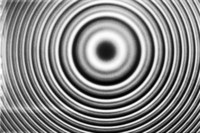
Photo from wikipedia
In-plane Fabry-Perot cavities based on deeply etched Bragg mirrors are used in many microphotonic applications including sensing, telecom, and swept laser devices. A main limitation to their performance is the… Click to show full abstract
In-plane Fabry-Perot cavities based on deeply etched Bragg mirrors are used in many microphotonic applications including sensing, telecom, and swept laser devices. A main limitation to their performance is the small free spectral range (FSR) and low finesse. The FSR limits the dynamic range or the wavelength tuning range, while the linewidth limits the resolution. In this work, we propose coupled Fabry-Perot micro-cavities that greatly enhance the FSR, besides reducing the linewidth, which lead to higher finesse and better performance. The proposed structure is modeled and etched on Si substrate to a depth of 150 μm using the deep reactive ion etching technology. Optical measurements indicate an enhanced FSR of more than 140 nm and a quality factor of 3152 using coupled cavities as compared to only 9 nm FSR for a single cavity of the same length. The over-etching and surface roughness, being the main effective fabrication tolerances, are modeled and extracted from the measurements.
Journal Title: Applied optics
Year Published: 2018
Link to full text (if available)
Share on Social Media: Sign Up to like & get
recommendations!